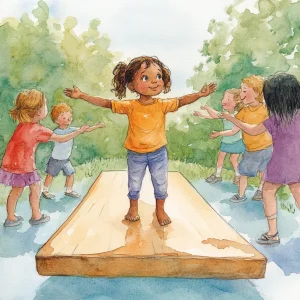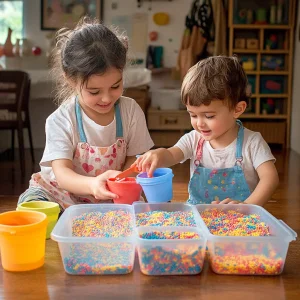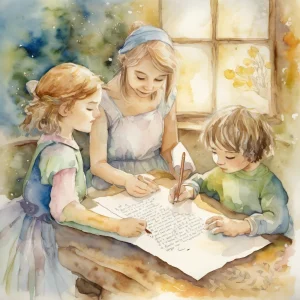Activity
Similar Activities
Sensory Music-Making Session: Sound Story Drawing Adventure
Children’s Age: 2–2.5 years
Activity Duration: 5 – 20 minutes
A sensory music-making activity using household items to enhance sensory development and introduce children to the world of music.
Activity Duration: 5 – 20 minutes
Balance Beam Adventure: Enhancing Coordination and Focus
Children’s Age: 2–12 years
Activity Duration: 5 minutes
This fun activity called "Balancing Act Fun" is perfect for kids aged 2 to 6. It helps improve coordination, balance, and self-regulation. You'll need a flat surface, a stable boar…
Activity Duration: 5 minutes
Enchanted Textures: Sensory Treasure Hunt Adventure
Children’s Age: 0 month – 6 years
Activity Duration: 5 – 10 minutes
Let's go on a Sensory Treasure Hunt adventure! We will explore different textures using our sense of touch. Gather textured items, hide them around the room, and guide the child to…
Activity Duration: 5 – 10 minutes
Sensory Exploration Journey: Household Items Adventure
Children’s Age: 0 month – 6 years
Activity Duration: 10 minutes
Let's explore different textures and shapes using household items! Find a big container and items like a wooden spoon, silk scarf, plastic cup, sponge, and cotton ball. Sit togethe…
Activity Duration: 10 minutes
Sensory Texture Hunt for Developing Skills
Children’s Age: 4–7 years
Activity Duration: 5 – 10 minutes
Let's go on a Sensory Treasure Hunt! We will explore different textures like smooth stones, soft feathers, and rough sandpaper. You can use blindfolds for an extra challenge if you…
Activity Duration: 5 – 10 minutes
Empathy Through Storytelling: Musical Sensory Experience
Children’s Age: 2–3 years
Activity Duration: 5 – 15 minutes
Let's dive into Musical Sensory Storytime! Get ready for a fun experience that will engage all your senses. We will read a story, play musical instruments, create art, and enjoy co…
Activity Duration: 5 – 15 minutes
Rainbow Rice Sensory Play Adventure
Children’s Age: 1.5–2 years
Activity Duration: 10 minutes
Engage toddlers aged 18 to 24 months in a sensory play activity using colored rice to enhance physical, social-emotional, and sensory development. Gather materials like uncooked wh…
Activity Duration: 10 minutes
Sensory Treasure Basket Exploration: Infant's Discovery Journey
Children’s Age: 3 – 6 months
Activity Duration: 10 minutes
Engage your 3 to 6-month-old baby in the Sensory Treasure Basket Exploration activity to boost their sensory development and curiosity. Fill a basket with soft fabric pieces, teeth…
Activity Duration: 10 minutes
Enchanted Sensory Treasure Basket Exploration
Children’s Age: 6 months – 1.5 years
Activity Duration: 10 minutes
Explore the "Sensory Treasure Basket Exploration" activity designed to engage children's senses and support motor development in a fun way. Simply gather safe objects with various …
Activity Duration: 10 minutes
Sensory Holiday Exploration: A Magical Journey
Children’s Age: 6 months – 1 year
Activity Duration: 5 – 10 minutes
The Sensory Holiday Exploration activity is designed for children aged 6 to 12 months to discover holiday-themed textures and colors. Using safe sensory items like scarves, bells, …
Activity Duration: 5 – 10 minutes
Enchanted Peek-a-Boo Sensory Fun Journey
Children’s Age: 6 months – 1 year
Activity Duration: 10 minutes
"Peek-a-Boo Sensory Fun" is a delightful activity that supports social-emotional development and sensory exploration in children. Using a soft scarf and favorite toy, caregivers ca…
Activity Duration: 10 minutes
Gratitude Journey: Writing Thank-You Notes Experiment
Children’s Age: 6–8 years
Activity Duration: 10 – 20 minutes
A creative activity for children aged 7-8 to write thank-you notes, enhancing cognitive and communication skills.
Activity Duration: 10 – 20 minutes



























